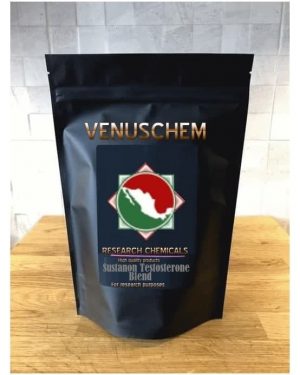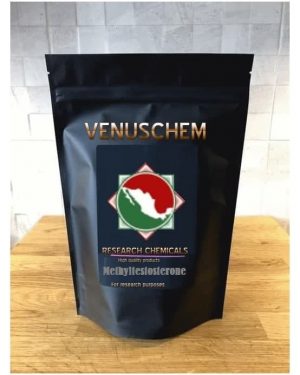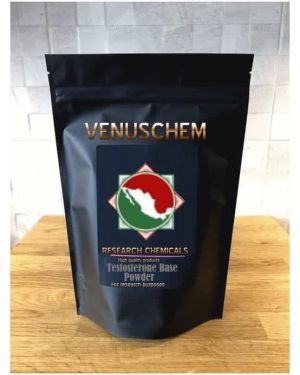Description
Mestanolone Powder
Mestanolone
Description
Mestanolone is an oral analogue of dihydrotestosterone.
This steroid is a 17-alpha methylated form of this potent endogenous androgen, being essentially (in structure) to dihydrotestosterone what methyltestosterone is to testosterone.
Overall, mestanolone has an activity profile not very dissimilar from the hormone it is derived from.
For starters, like dihydrotestosterone, mestanolone is primarily androgenic in nature, displaying a low level of anabolic activity.
Both dihydrotestosterone and mestanolone are also devoid of estrogenic activity.
Addiction Potential
There is insufficient evidence to prove a causal link between anabolic steroid use and addiction or dependence. However, there is evidence to support the positive psychological and physical effects experienced by many users, leading to reinforce the continuing use of steroids.
Furthermore, the escalating dosage often reported by users together with a preoccupation with the drugs themselves and the associated lifestyle indicates some commonality with drug dependency syndromes.
While this is not exhibited by all users of anabolic steroids, there appears to be a number of users for whom this is the case.
Short Term Effects
Androgenic: Mestanolone is an androgen.
Higher than normal therapeutic doses are likely to produce androgenic side effects including oily skin, acne, and body/facial hair growth.
Men with a genetic predisposition for hair loss (androgenetic alopecia) may notice accelerated male pattern balding. Women are warned of the potential virilizing effects of anabolic/androgenic steroids, especially with such a strong androgen.
These may include deepening of the voice, menstrual irregularities, changes in skin texture, facial hair growth, and clitoral enlargement. Hepatotoxicity: Mestanolone is a C17-alpha alkylated compound.
This alteration protects the drug from deactivation by the liver, allowing a very high percentage of the drug entry into the bloodstream following oral administration. C17-alpha alkylated anabolic/androgenic steroids can be hepatotoxic.
Prolonged or high exposure may result in liver damage. In rare instances life-threatening dysfunction may develop. It is advisable to visit a physician periodically during each cycle to monitor liver function and overall health.
Intake of C17-alpha alkylated steroids is commonly limited to 6-8 weeks, in an effort to avoid escalating liver strain. Cardiovascular: Anabolic/androgenic steroids can have deleterious effects on serum cholesterol.
This includes a tendency to reduce HDL (good) cholesterol values and increase LDL (bad) cholesterol values, which may shift the HDL to LDL balance in a direction that favors greater risk of arteriosclerosis.
The relative impact of an anabolic/androgenic steroid on serum lipids is dependant on the dose, route of administration (oral vs. injectable), type of steroid (aromatizable or non-aromatizable), and level of resistance to hepatic metabolism.
Although not extensively studied in humans, the oral route, high relative potency, and non-aromatizable nature of methyltrienolone suggest that this agent is extremely prone to negatively altering lipid values and increasing atherogenic risk.
Anabolic/androgenic steroids may also adversely affect blood pressure and triglycerides, reduce endothelial relaxation, and support left ventricular hypertrophy, all potentially increasing the risk of cardiovascular disease and myocardiai infarction.
Testosterone Suppression: All anabolic/androgenic steroids when taken in doses sufficient to promote muscle gain are expected to suppress endogenous testosterone production.
Long Term Effects
Dermatological & Hair: Male pattern baldness has been shown to be androgen-dependent (Randall, 2004).
It is conceivable that in those who are genetically predisposed to this form of scalp hair loss, the use of certain types of steroids could accelerate the progression of hair loss.
Conversely, many steroid users report increased growth of body hair when using steroids.
From the limited data available growth of facial hair may be particularly pronounced in female users.
Gynaecomastia: Gynaecomastia is the growth of the glandular breast tissue in males, caused by an imbalance in the ratio of oestrogen to testosterone.
This imbalance is a direct result of an excess of testosterone resulting in aromatisation (conversion of excess testosterone into an oestrogen like compound.
This in turn can cause the growth of breast tissue and female fat distribution.
Those anabolic steroids with a high androgenic component are more likely to result in this adverse effect.
Many of the drugs commonly used in conjunction with anabolic steroids such as growth hormone, human chorionic gonadotrophin, spironolactone) have also been clinically associated with gynaecomastia. Genitourinary: Anabolic steroid use can suppress endogenous testosterone leading to shrinkage of the testes.
It can take a prolonged period for testicular production and fertility to recover. Many anabolic steroid users report increased libido while using steroids, conversely on cessation of use, libido is often decreased below original levels. Erectile dysfunction has also been reported both during use and following cessation of use.
There have been a small number of case reports of renal cancers in individuals who reported use of anabolic steroids.
But, as in the case of many of the more serious side effects of anabolic steroids, a causal link has not been fully ascertained. Liver:
The use of anabolic steroids, in particular oral C17 alpha alkylated steroids (such as methandienone and oxymetholone), has been associated with disease and dysfunction of the liver, with cases of jaundice being relatively common.
The extent of impact on liver function is inconclusive with studies reporting diverse results and conclusions. However, there have been a small number of case reports of liver tumours in anabolic steroid users. Cardiovascular:
The use of anabolic steroids has been associated with a range of both acute and chronic cardiovascular pathologies. Reported adverse effects include hypertension, altered lipid metabolism, altered haemostatic system, cardiac arrhythmias, myocardial infarction, stroke, thrombosis, sudden cardiac death and cardiac hypertrophy However, much of the data related to these cases is equivocal.





